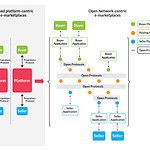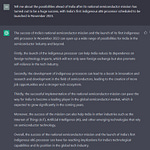Cyberpolitik #1: France’s Influence Operations Doctrine
— Prateek Waghre
In October, France announced a new doctrine for Information Warfare. This development has received surprisingly little attention in English-language discourse over the last three weeks. It was initially reported by Francesco Busseletti, who highlighted:
Objective: to counter the growing spread of fake news and disinformation, aimed at weakening the image of Paris and weakening its armed forces, especially abroad such as the Sahel. Considering that its adversaries no longer hesitate to use the weapon of social media against its military operations, France intends to “win the war before the war”. Its strategy boils down to “being on the offensive” …
The Defence Minister Florence Parly’s speech also highlighted this aspect of the “war before the war”. Here’s an excerpt from a google-translated version of her speech.
“When used wisely, the weapon of information allows you to win without fighting.”
What does the doctrine say?
The doctrine identifies six characteristics of the “informational layer of cyberspace”:
Contraction of space and time.
Ability to conceal/falsify origin due to anonymity.
Difficulty with erasing information since it can be duplicated, moved, and re-used without the original context.
Any individual can produce and broadcast information. (The minister’s speech seems to have gone as far as stating these individual and anonymous actors are at par with media organisations)
The point is that social networks have an equalizing power: on Twitter, the voice of an anonymous user counts as much as that of a major media whose essential function is to inform (sic).
Continuous innovation such as deepfakes, AI, AR/VR, etc.
The presence of operators who impose their own regulations. A challenge for law enforcement as the space is ‘dematerialised.
It defines two types of actors that threaten armed forces:

Noting that information war is already an everyday reality for the military, it goes on to say that ‘mastery’ in the information field is now a pre-condition for ‘operational superiority’. And that cyberspace offers opportunities to create effects in ‘both information and physical environments’.
The document is peppered with many important statements about Lutte Informatique D’influence (L2I).
Definition:
military operations conducted in the informational layer of cyberspace to detect, characterize and counter attacks, support StratCom, provide information or (perform) deception, independently or in combination with other operations.
L2I stands at “the confluence of cyber defence and influence”. And that it requires skills in common with LID (defensive cyber operations) and LIO (offensive cyber operations).
L2I offers opportunities for ‘intelligence gathering’ and ‘deception' operations’. (The minister’s speech defined some boundaries explicitly)
the French armies will not conduct an information operation (within) the national territory. The French armies … will not destabilize a foreign state through information actions that would target, for example, its electoral processes.
As future challenges, the doctrine identifies the need to build skills and tools, as well as cooperation with firms that specialise in the field and coalitions with allies to coordinate responses.
Operationally, this would fall within the purview of the Chief of Staff of the armed forces, who would further rely on the Cyber Defense Commander (COMCYBER) and specialised military units.
Two more questions
For France to come out and explicitly state its doctrine is undoubtedly a significant step. But this also raises two broader questions.
What should other democracies do?
What will DCN operators do?
Camille Francois rightly points out that it raises the question of what democracies can/should do in this space and the possibility of gaining a better understanding of techniques used by countries not named - Russia, China, or Iran.



Thomas Rid, in his book Active Measures, argues that liberal democracies cannot be good at disinformation.
“For liberal democracies in particular, disinformation represents a double threat: being at the receiving end of active measures will undermine democratic institutions—and giving in to the temptation to design and deploy them will have the same result. It is impossible to excel at disinformation and at democracy at the same time. The stronger and the more robust a democratic body politic, the more resistant to disinformation it will be—and the more reluctant to deploy and optimize disinformation. Weakened democracies, in turn, succumb more easily to the temptations of active measures.”
Then, there’s the question of Digital Communication Networks which have become the battlefield for such operations. As Lukasz Olenik notes in his overview of the French doctrine, Facebook has taken action against Coordinated Inauthentic Behaviour it identified originating from a network with links to the French Military in December 2020:
We found this activity as part of our internal investigation into suspected coordinated inauthentic behavior in Francophone Africa. Although the people behind it attempted to conceal their identities and coordination, our investigation found links to individuals associated with French military.
Now that France has explicitly stated its doctrine (and maybe others will follow), will platforms act more aggressively, considering they are already under fire for either enabling or not doing enough to mitigate the fallout from influence operations? Or, will there be wink-wink-nudge-nudge arrangements between them and a particular set of states?


Note: Google Translate was used for French to English translations.
If you enjoy this newsletter please consider taking our 12 week Graduate Certificate Programmes in Technology & Policy, Public Policy, Defence & Foreign Affairs and Health & Life Sciences.
Click here to apply and know more. You can also get a gift coupon worth ₹1000 every time you successfully refer a friend to our programmes.
Siliconpolitik #1: AI Chips
— Arjun Gargeyas
What are They?
One of the emerging applications of semiconductor devices is the concept of Artificial Intelligence (AI) chips. With new and emerging technologies cropping up, there is an increased need for chipsets with increasing computational power and capabilities. Technologies like Machine Learning and Deep Neural Networks, which are part of the AI ecosystem, have a tremendous workload that cannot be fulfilled by traditional chipsets. AI algorithms work on parallel processing or parallelism, which is the ability to multitask and simultaneously run different computational processes. AI chips, in recent years, have tried to incorporate the needs of AI algorithms into chipsets that can be used both in the cloud as well as at network edges (in smartphones, tablets, and other consumer devices).
The diverse applications of AI chips have increased its role in the global economy with companies from various industries all looking to maximise the benefits of AI chip technology. Robotics and autonomous driving, for example, need AI algorithms for efficient and effective working, with the computational power of the chipsets needing incredibly fast processing speeds. This has evolved the role of chipsets with AI capabilities from only being used in the cloud or servers to being used in consumer products at the network edges. However, applications such as Biometrics and Image Recognition need AI chips in the cloud or servers for maintaining a large amount of data. The use of AI chips remains integral in data centers which eventually reduces operational costs and improves information management.
Why They Matter
The market for AI chips has consistently increased in the last decade with AI chipsets projected to account for 22% of the global AI revenue by 2022. A strong compounded annual growth rate of 54% has been projected for the AI chips market with technologically advanced regions like the Americas and Europe dominating the market in the future. AI chips also rely on a variety of companies, ranging from smartphone manufacturers like Apple, Samsung, and Huawei, to traditional chip designers like Qualcomm and MediaTek, to intellectual property (IP) license providers like ARM. With most of the major semiconductor companies across the world in the business, AI chips look to be the next big thing for the industry.
Semiconductor companies have already thrown their hats in the AI ring with the development of advanced AI chips like Graphical Processing Units (GPUs). NVIDIA has a dedicated application programming language called CUDA used in parallel computing on GPUs. Other targeted AI chips like Field Programmable Gate Arrays (FPGAs) and Application Specific Integrated Circuits (ASICs) are developed for specific applications of AI technology. Companies like Microsoft and Google have also invested in the manufacture of these chipsets keeping in mind specific needs such as the speech processing unit of Google Assistant.
With increasing global economic revenue and a large market ripe for capture, the presence of China in the AI chips has also been increasing. AI chip funding activity in China has been driven by the hope of creating industry-leading capabilities in machine learning, deep compression, pruning, and system-level optimization for neural networks. Chinese technology companies like Alibaba and Huawei have invested heavily in the manufacture of AI chips for smartphones and other devices. Some Bitcoin mining equipment manufacturers are also getting into the AI optimization game. With domestic AI research in China still playing catch up to the capabilities of Western countries like the United States, these local manufacturing companies have relied on tweaking existing algorithms to create modified AI models. But increased investments along with state support and financing, similar to the semiconductor industry in China, has made AI chips an important technology worth pursuing in technologically adept states. The race for the domination of the global AI chips markets is something to watch out for in the very near future.
Cyberpolitik #2: Are Norms Possible?
— Sapni G K
Since the last edition of this newsletter, much has happened on cyberspace and international action for establishing norms for its operation and regulation. The United States of America joined the Paris Call for Trust and Security in the cyberspace. The 2018 Call led by the French, proposes a multi-stakeholder model for laying down norms for activity in cyberspace during peacetime. This includes, but is not limited to cybersecurity and the concerns of systemic harms to individuals and critical infrastructure. The Call details nine principles that are open for states, local governments, companies, and civil society organizations to support.
Protect individuals and infrastructure
Protect the internet
Defend electoral processes
Defend intellectual property
Non-proliferation
Lifecycle security
Cyber hygiene
No private hack back
International norms
They incorporate norms of international law, including the ideas put forth by the UDHR, customary international law, and state laws on the governance of information and communication technologies. This operates as a non-binding, non-enforceable set of principles that are to guide the supporters of the Call and their actions. Most major US tech companies including Microsoft, Google, Facebook Inc (now Meta) are already supporters of the Call and have engaged closely with the various associated working groups. However, the US officially supporting the Call signals that it is no longer holding back in international norm-setting in cyberspace. This could also be read as a furtherance of the USA’s reinvigorated interest in cyber norms, both in peacetime and military applications, as evidenced by recent documents such as the 2021 Interim National Security Strategic Guidance and the recent report by the Department of Defense. However, it is noteworthy that the US has not yet made any concrete steps to sign up to the Global Commission on the Stability of Cyberspace, an effort led by research institutes in the Netherlands and Singapore with the support of the French, Dutch, and Singapore governments, which is also engaged in drawing out international norms for cyberspace during peacetime and armed conflict.
China, Russia, Israel, and Iran are other major actors in cyberspace that have not supported the call yet. This is indicative of the fissures in international norm-setting on cyberspace, particularly when China is marching ahead creating a regulatory environment that can have ripple effects internationally. India has not officially supported the Call, but several Indian enterprises and the Karnataka Centre of Excellence of Cybersecurity have joined the Call. It is a proposal worth consideration for the Indian government. An early head start can give India a definitive say in the development of doctrines as well as import legislative principles that can be beneficial to the many millions of Indians who go online every day.
Siliconpolitik #2: US-China-Chips — It’s Complicated
— Pranay Kotasthane
Three recent news reports have turned the world's attention back to the links between the US and China in the semiconductor domain. Until now, the commonplace understanding is that the US is focused on constraining China's progress in the semiconductor domain, a weak link in China's otherwise impressive technology stack. These news reports contest this narrative by suggesting the constraints don't seem to be working, as many US investors and firms are still flocking to China.
WSJ reports that between 2017 and 2020, many US companies, including Intel, have invested in Chinese design companies. The number of deals (58) has more than doubled when compared to the 2013-2016 period.
Bloomberg reports Intel wanted to start a manufacturing plant in Chengdu, but the White House officials discouraged it.
These reports come on the heels of another big claim in mid-October, when Alibaba unveiled a 5nm server chip, making many heads turn. This news seemed to indicate that China's pursuit of semiconductor self-sufficiency is bearing fruit despite the geopolitical headwinds.
Connecting the Dots
Intel seems to be interested in China a lot. While the WSJ report showed that Intel is among the active investors in a Chinese Electronic Design Automation (EDA) firm, the Bloomberg report points out that Intel also wants to build a fab in Chengdu. It’s notable that both these stages of the semiconductor value chain are precisely where the US had planned to restrict Chinese access during the Trump administration. Reportedly, the US NSA Jake Sullivan and a few senators, want to change the investment screening methods to prevent such deals in the future.
Why are US companies still rushing to China?
The supply side: The Chinese government's incentives are 'crowding in' investments from Chinese firms and global semiconductor players alike.
The demand side: A significant number of customers of chip makers are based in China - laptop manufacturers, phone manufacturers, servers etc. Companies still want a piece of that pie because homegrown alternatives in China are not enough, yet. It's a mouth-watering market, still.
My initial assessment
The number of investment deals between 2017-20 (58) doesn't sound that big in the overall scheme of things. They also mostly appear to be in chip design firms. What this does suggest is like many industrial policies, there is a crowding-in of capital. When a player the size of the Chinese government throws big money at a problem (starting the Chip Fund in 2014), this is expected to happen. There will be national champions and duds, both. The question really is, how long such subsidies can be sustained.
The time period 2017-2020 suggests that the US companies rushed into China before the Trump administration tightened the export controls.
Intel's investment in a Chinese EDA firm and a possible fab is indeed worrying. Although, the tone of the Chengdu fab proposal suggests it is more a tactic to get the CHIPS Act passed in the US, which will guarantee big subsidies for the likes of Intel back home. The report had no numbers, or plans, just a few unnamed sources.
The demand side question is an important one. As long as China remains the hub for electronics Original Equipment Manufacturers (OEMs), chip makers will find it attractive to sell their products to China. Solving this will require a plurilateral effort to move electronics manufacturing -- and not leading-edge chip manufacturing alone -- out of China.
Finally, the Alibaba server chip news report has many unknowns. Unveiling a chip is different from being able to produce it. Manufacturing at 5nm is not possible in China. They must rely on TSMC (and now Samsung) for this purpose. Moreover, the processor IP is still ARM, something that Alibaba hasn't been able to displace.
The reportage of the kind WSJ, Bloomberg is putting out is indicative of the change in mindset in the US. A few years ago, no one would have even cared about such investments. These are front-page news items now.
I expect some more export controls and more subsidies from the US government, both.
Our Reading Menu
1. [Full Text] of the Paris Call for Trust and Security in the cyberspace
2. [Full Text] 2021 Interim National Security Strategic Guidance of the White house
3. [Policy Study] Principles for Content Policy and Governance by Chris Riley, R Street
4. [Article] by Oleg Shakirov discussing the US-Russia rapprochement on Information and Cyber Security
5. [Blog] by Oleg Shakirov explaining why US-Russia cooperation on countering Ransomware threats makes sense













Share this post